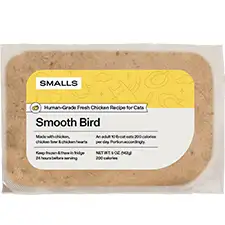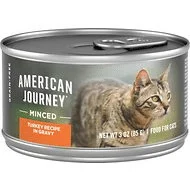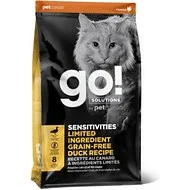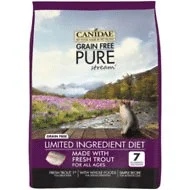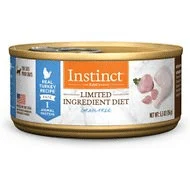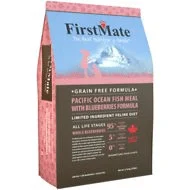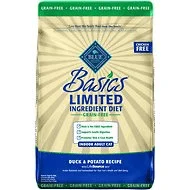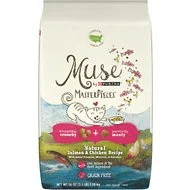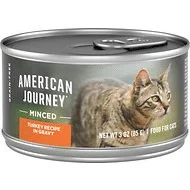9 Best (Highest Quality) Cat Foods for Skin Allergies
Quick Guide
- What Is The Best Cat Food For Skin Allergies?
- Understanding Skin Allergies in Cats
- Is There a Difference Between Skin Allergies and Food Allergies?
- What to Look for in a Good Cat Food for Skin Allergies
- How Do We Make Our Recommendations?
- The 9 Best Cat Foods for Skin Allergies
- 5 More Top-Rated Cat Foods for Skin Allergies
- Canidae Grain-Free PURE Stream with Trout Limited Ingredient Diet Dry Cat Food
- Instinct by Nature’s Variety Limited Ingredient Diet Grain-Free Real Turkey Recipe Natural Wet Food
- FirstMate Pacific Ocean Fish Meal with Blueberries Formula LID Grain-Free Dry Cat Food
- Blue Buffalo Basics Limited Ingredient Grain-Free Formula Duck & Potato Indoor Cat Food
- Purina Muse Masterpieces Natural Salmon & Chicken Recipe Dry Food
- Frequently Asked Questions
Does your cat seem to be scratching more than usual? Does he groom himself to the point that he’s losing patches of hair? Do you notice small scabs or worse, large lesions forming on this back or belly?
All of these symptoms point toward a big problem – skin allergies. A little bit of itching and scratching is normal, but if it becomes a chronic and recurring issue, it might be something more than just the occasional itch. Skin allergies can be triggered by a variety of things, and it isn’t always easy to tell what the trigger is. The more you learn about skin allergies, the better you’ll be able to discern the cause of your cat’s symptoms of they develop and the sooner you can seek veterinary care.
In this article, we’ll explore the subject of skin allergies in cats including what they are, what symptoms they produce, and how to treat them. We’ll also take a closer look at the difference between skin allergies and food allergies in cats, focusing particularly on the dietary implications of both. Finally, you’ll see our top picks for the best cat food for skin allergies.
What Is The Best Cat Food For Skin Allergies?
- Smalls Fresh Cat Food Delivery
- Taste of the Wild Canyon River Grain-Free Dry Cat Food
- American Journey Minced Turkey Recipe in Gravy Grain-Free
- Go! Sensitivities Limited Ingredient Duck Grain-Free Dry Cat Food
- Canidae Grain-Free PURE Stream with Trout Limited Ingredient Diet
- Instinct by Nature’s Variety Limited Ingredient Diet Grain-Free Real Turkey
- FirstMate Pacific Ocean Fish Meal with Blueberries Formula LID Grain-Free
- Blue Buffalo Basics Limited Ingredient Grain-Free Formula Duck & Potato
- Purina Muse Masterpieces Natural Salmon & Chicken Recipe
Understanding Skin Allergies in Cats
It is normal for your cat to scratch the occasional itch, but frequent scratching and intense itching is not normal. If your cat develops itchy skin, it may be due to a skin allergy or infection and you need to talk to your vet immediately to diagnose and treat the issue. Left untreated, itchy skin can cause your cat to groom itself excessively which may lead to the formation of lesions. When your cat develops skin lesions or breaks the skin from intense scratching, he becomes susceptible to a secondary infection.
The condition of your cat’s skin and coat is the biggest indicator of whether he is suffering from an allergy. It isn’t always easy, however, to determine the cause of that allergy.
Here are some of the most common symptoms of skin allergies in cats:
- Dry and itchy skin
- Small scabs on the skin
- Broad areas of redness or inflammation
- Lesions on the face, abdomen, or legs
- Frequent and excessive scratching
- Excessive grooming
- Hair breakage or hair loss
Though it can be trick to identify the trigger for your cat’s skin allergies, there are three primary culprits to consider: external parasites, something in their diet, or something in their environment.
External parasites like fleas and mites can cause your cat to itch and scratch, but some cats even develop an allergy to the infestation itself. Young kittens and immune-compromised older cats are more susceptible to developing allergies to flea bites and they can also have a more severe reaction to demodectic or sarcoptic mange. Food allergens can be caused by anything from common proteins like chicken and beef to food additives like artificial preservatives. Some cats even develop contact and inhalant allergies to environmental triggers like dust, pollen, or smoke.
Now that you have a better understanding of this health problem, you may be wondering which is the best option for rodent ulcer treatment. In the next section, we’ll talk about treatment options and explore how changing your cat’s diet might help.
Is There a Difference Between Skin Allergies and Food Allergies?
By now it should be clear that cat food allergies are very different from food allergies in people. A majority of cats who develop a food allergy present with skin-related symptoms, not necessarily digestive symptoms. But that doesn’t necessarily mean that every cat who develops skin-related allergy symptoms has a food allergy.
Here are some questions you can ask yourself to help determine whether your cat’s skin problems are related to food or another type of allergy:
- Where are your cat’s skin symptoms concentrated? Flea allergies happen at the base of the tail or neck and on the hips, groin and thighs. Food allergies and airborne allergies cause itching on the face, ears, belly, and feet. Allergies to mites cause itching and lesions on the ears, elbows, belly, and legs.
- When did you first notice symptoms of the allergy? Mange is most common in younger kittens, as are flea allergies. If the symptoms line up with a change in diet, food allergies are likely the cause.
- Do your cat’s symptoms worsen in certain seasons or do they happen year-round? Seasonal allergies are often caused by environmental and airborne allergens. Food allergies cause symptoms all year-round.
- Did your cat develop itching first or skin lesions and hair loss? Allergies and scabies are the most likely cause of itchy skin, though they can develop into lesions if left untreated. Skin lesions and hair loss are more commonly caused by mange, fungal infections, bacterial infections, or hormonal imbalance.
- Have you tried any medications or treatments that have helped? If your cat’s symptoms responded to some kind of medication or treatment, it is likely an allergy to parasites or environmental/airborne allergens. Food allergies will not respond to medical treatments, though certain therapies may help soothe the symptoms.
- Have your cat’s symptoms spread to other pets in the house? Mange mites, fleas, and ringworm (a bacterial infection) can be spread to other pets or people in the household. Food allergies are not contagious, though it is possible for other cats to develop the same allergy simply from repeated exposure to the ingredient.
It can be difficult to determine whether your cat’s skin problems are caused by food allergies or another type of allergy but conducting a food trial is a quick way to rule out one of those two options. Read on to learn how to treat food intolerance in cats with a hypoallergenic diet and to learn what food is good for cats with allergies.
What to Look for in a Good Cat Food for Skin Allergies
If you and your veterinarian are confident that your cat’s skin allergies are triggered by a certain food ingredient, the solution is actually quite simple. The best way for how to treat food intolerance in cats is to simply stop exposing your cat to the offending ingredient. Just find a new cat food that doesn’t contain the ingredient he is allergic to and his symptoms should go away on their own. You may need to take a few steps to identify the triggering ingredient but choosing a cat food to switch to is easy.
Here are some of the things we look for in a good cat food for skin allergies:
- Natural whole-food ingredients. Whole food ingredients are more digestible for cats and less likely to trigger a reaction, so make sure your cat’s food is all-natural with real ingredients.
- Novel source of animal protein. Protein should be the first ingredient in your cat’s food, and it needs to come from an animal to make it a complete source of protein. When choosing a cat food for allergies, choose a novel protein – one your cat hasn’t eaten before.
- Digestible carbohydrates. Grain allergies are actually not very common in cats, so unless you’ve confirmed a grain allergy in your cat, look for recipes with whole-grain carbohydrates. Other digestible carbohydrates include fresh and starchy vegetables.
- Free from fillers, by-products, and artificial additives. Though proteins like chicken and beef are the most common cat food allergens, many cats also react to low-quality ingredients like fillers, by-products and artificial additives (colors, flavors, and preservatives), so avoid these as well.
- Beneficial supplements. In addition to making sure your cat’s food doesn’t contain things that will trigger allergies, you need to make sure that is DOES contain beneficial supplements. Vitamin and mineral supplements ensure nutritional adequacy and probiotics support digestion.
Switching your cat to a hypoallergenic recipe is an important first step in resolving his skin problems. You may find yourself wondering, however, how long for cat food allergies to go away? You’ll find more information below in the FAQs, but you can expect your cat’s symptoms to resolve within 8 to 12 weeks on an elimination diet. That is assuming, of course, that his skin problems are actually an allergic reaction to food. Read on to see our recommendations and to learn how we make them.
How Do We Make Our Recommendations?
Here at Petsumer, we seek to provide you with the information you need to make smart and educated choices for your pets. Before we make any pet food recommendations, we do our due diligence to ensure that every product on our list is one we would be happy to feed our own pets. We consider the minimum nutritional needs of cats and double-check every recipe for high-quality, natural ingredients.
Here are some of the requirements for a cat food to receive our recommendation:
- A source of high-quality animal protein as the first ingredient
- At least 30% crude protein for kittens and at least 26% for adults
- A minimum of 9% crude fat for kittens and adults
- A balance of omega-3 and omega-6 fatty acids, primarily from animal sources
- A rich blend of nutrients from natural sources and supplements, as needed
- Limited carbohydrate content from digestible sources (like whole grains and veggies)
- No low-quality fillers, by-products, or artificial additives (preservatives, dyes, or flavors)
The 9 Best Cat Foods for Skin Allergies
If you’re wondering what food is good for cats with allergies, you’ll be glad to know that there are many different options to choose from. With the info you’ve received, you are equipped to start shopping on your own for new cat food. If you’re still not sure where to start, consider one of our recommendations below. Here are our top picks for the best wet food and best dry cat food for allergies.
| Our 2024 Picks: Best Cat Foods for Skin Allergies | |||
Smalls Fresh Cat Food Delivery
|
CHECK PRICE | ||
Taste Of The Wild Canyon River
|
CHECK PRICE | ||
American Journey Minced Turkey
|
CHECK PRICE | ||
Go! Sensitivities Limited Ingredient Duck Grain-Free
|
CHECK PRICE | ||
Canidae Grain-Free PURE Stream with Trout Limited
|
CHECK PRICE | ||
Instinct by Nature’s Variety Limited Ingredient Diet
|
CHECK PRICE | ||
FirstMate Pacific Ocean Fish Meal with Blueberries Formula LID
|
CHECK PRICE | ||
Blue Buffalo Basics Limited Ingredient Grain-Free
|
CHECK PRICE | ||
Purina Muse Masterpieces Natural Salmon & Chicken
|
CHECK PRICE | ||
Smalls Fresh Bird Cat Food Delivery
Overall Best Cat Food for Skin Allergies: When it comes to your cat’s nutrition, you want to feed him the best of the best. High-quality, natural ingredients are the key to digestibility and to minimizing your cat’s risk for food allergies and skin problems. Smalls is our top pick because it is fresh cat food prepared from premium ingredients, cooked in small batches, and delivered right to your door. At Smalls, quality is the goal and they don’t cut any corners. Simply provide some basic information about your cat so they can calculate his calorie needs, then choose from two protein options. You’ll receive customized packages of freshly prepared cat food sent to your door on a regular basis. All you have to do is feed your cat!
- Pros: Real food ingredients, prepared in small batches, premium animal proteins, fresh fruits and vegetables, highly nutritious and digestible, delivered right to your door
- Cons: Very expensive compared to average kibble, only two protein options to choose from
Taste of the Wild Canyon River Grain-Free Dry Cat Food
Most Popular Cat Food for Skin Allergies: If you can’t decide among the different cat food brands out there, you can always go with a popular one like Taste of the Wild. Not only is this one of our favorite brands, but it is also one of our top picks for the best dry cat food for allergies. This formula features fresh trout as a novel source of protein and the first ingredient. It also contains ocean fish meal and smoked salmon as supplemental proteins, both of which are also novel proteins for many cats. This grain-free recipe is highly digestible, featuring sweet potatoes and potatoes as the main carbohydrates. You’ll also find fresh fruits and vegetables in this recipe which provide natural sources for key nutrients, not to mention anti-inflammatory ingredients and rich in antioxidants to support your cat’s immune system. This recipe contains no artificial additives or byproducts and is supplemented with prebiotic fiber, probiotics, and chelated minerals.
- Pros: Novel source of animal protein, several supplemental proteins, highly digestible natural ingredients, fresh fruits and vegetables, prebiotic fiber and probiotics, chelated minerals
- Cons: Not a single-source protein recipe, contains some plant proteins (pea and potato proteins)
American Journey Minced Turkey Recipe in Gravy Grain-Free Canned Cat Food
Most Affordable Cat Food for Skin Allergies: If you’re looking for an affordable cat food that won’t trigger your cat’s allergies or sensitivities, consider this American Journey Minced Turkey recipe canned food. It features fresh turkey as the main ingredient and a single, novel source of animal protein. It also contains both turkey broth and chicken broth for maximum flavor and a higher concentration of moisture to boost your cat’s hydration. This recipe contains flaxseed, sunflower oil, and fish oil to provide the ideal balanced of omega-3 and omega-6 fatty acids to support your cat’s skin and coat health, helping him recover from his skin allergy symptoms. Overall, this recipe provides 9% crude protein and 4% fat with 1% fiber which, converted to a dry matter calculation is about 50% protein and 22% fat with 5.5% fiber.
- Pros: Single source of novel protein, digestible natural ingredients, rich in flavor and moisture, blend of omega-3 and omega-6 fatty acids, chelated mineral supplements, fresh fruits and veggies
- Cons: Contains some thickener (guar gum), first source of fat is plant-based (flaxseed)
Go! Sensitivities Limited Ingredient Duck Grain-Free Dry Cat Food
Best Cat Food for Skin Allergies and Sensitive Stomach: Skin allergies can limit the ingredients your cat is able to tolerate but things get even more complicated when your cat has a sensitive stomach. The key to addressing all of these issues is a healthy, high-quality cat food made with real food ingredients. Better yet, a limited number of ingredients including a novel source of premium animal protein. This Go! Sensitivities Limited Ingredient Duck recipe dry food includes just 8 key ingredients, featuring cage-free duck as the main ingredient. This recipe is complete and balanced for all life stages, so you don’t have to worry about switching your kitten to a different adult recipe or your adult cat to a senior formula. It is made with only high-quality, digestible ingredients and it is full of natural flavor and skin- and coat-supporting omega fatty acids.
- Pros: Single novel source of protein, limited ingredient diet, free from common allergens and by-products, highly digestible natural ingredients, complete and balanced for all life stages
- Cons: Expensive compared to traditional kibble
5 More Top-Rated Cat Foods for Skin Allergies
Every cat is different, and it is important to remember that the only recipe that will be hypoallergenic for your cat is one that doesn’t contain the ingredients he is specifically allergic to. To give you a few more options to consider, here are another 5 top-rated picks:
Canidae Grain-Free PURE Stream with Trout Limited Ingredient Diet Dry Cat Food
If you’re looking for a limited ingredient diet made with novel animal proteins, the Canidae PURE line of grain-free cat foods offers a variety of choices. This particular recipe features just 7 key ingredients with fresh trout as the main ingredient. You’ll also find supplemental proteins like salmon meal and menhaden fish meal, with a rich blend of omega-3 and omega-6 fatty acids from the fish and canola oil. This recipe is highly digestible due to the low number of ingredients, all of which are completely natural. You’ll also find an assortment of vitamin and chelated mineral supplements to ensure complete and balanced nutrition as well as probiotics for healthy digestion.
Instinct by Nature’s Variety Limited Ingredient Diet Grain-Free Real Turkey Recipe Natural Wet Food
If you prefer to feed your cat wet food, this limited ingredient diet from Instinct by Nature’s Variety is a great choice. It contains fresh turkey and turkey liver as a single source of premium animal protein along with a very limited list of other key ingredients. Turkey broth provides moisture and natural flavor while peas act as the primary source of carbohydrate. This recipe is complete and balanced with the help of vitamin and chelated mineral supplements, plus it is completely free from by-products and artificial additives that might trigger skin allergies. Overall, this recipe provides 11.5% crude protein and 7% fat with 2% fiber which, converted to a dry matter calculation is about 48% protein and 29% fat.
FirstMate Pacific Ocean Fish Meal with Blueberries Formula LID Grain-Free Dry Cat Food
The FirstMate brand of cat food is made in Canada, but we love the quality of their ingredients and we consider it a brand you can trust. This particular recipe contains 95% protein from Pacific Ocean fish meal with only 5% protein from vegetables. It is a limited ingredient formula made with digestible grain-free carbohydrates and supplemented with whole blueberries as a natural source of key nutrients, not to mention immune-boosting antioxidants. This recipe contains chelated minerals as well which are minerals bound to protein molecules to increase their absorption. Overall, this recipe provides 42% protein and 18% fat with 3% fiber at 574 calories per cup. Just be mindful that this is a high-calorie recipe, so pay close attention to the feeding recommendations.
Blue Buffalo Basics Limited Ingredient Grain-Free Formula Duck & Potato Indoor Cat Food
The Blue Buffalo Basics line includes several limited ingredient formulas featuring novel animal proteins. This particular recipe features duck, including both fresh duck and duck meal as the top two ingredients. It is a grain-free recipe with peas, tapioca, and potatoes as the primary carbohydrates. You’ll find a rich blend of omega-3 and omega-6 fatty acids in this formula which is great for your cat’s skin and coat health. Plus, it contains fresh fruits and vegetables which, in addition to being rich in antioxidants and anti-inflammatory ingredients, offer natural sources for key vitamins and minerals. Just to ensure complete and balanced nutrition, this recipe also contains vitamins and chelated mineral supplements. Overall, it provides 30% crude protein and 14% fat at 402 calories per cup.
Purina Muse Masterpieces Natural Salmon & Chicken Recipe Dry Food
When it comes to their pet food products, Purina is not our favorite brand. However, in recent years they have been reformulating some of their recipes and developing new, more natural lines of pet food. Muse is one of these product lines and we don’t hate the products in it. This particular recipe features real salmon as the first ingredient, paired with digestible grain-free carbohydrates. The one thing to be wary of with this recipe is that it does contain chicken and beef ingredients, so if your cat is allergic or sensitive to these it should be avoided. As a whole, however, it is very digestible and is supposedly formulated for cats with food allergies and sensitivities.
Frequently Asked Questions
- What ingredient in cat food causes allergies? – Cat food allergies are not as common as pet food manufacturers would have you believe, but they do happen. The thing you need to realize is that the most common food allergies in cats are triggered by proteins, not by grains. Grains are actually one of the least common triggers for food sensitivity in cats. Common proteins like chicken, beef, fish, and dairy are more likely to cause a reaction. Your cat could also react to fillers, by-products, and artificial additives in his food.
- How can I soothe my cat’s itchy skin? – Itchy skin is a common symptom of allergies in cats, both food allergies and contact allergies. The best way to treat these issues is to prevent your cat from coming into contact with this allergen. Unfortunately, this might be easier said than done if your cat is allergic to something like dust. Fortunately, there are some simple things you can do at home to soothe your cat’s itchy skin. One option is to bathe your cat with a sensitive skin shampoo or use an allergy relief spray. Increasing your cat’s intake of essential fatty acids may help as well, so try a fish oil supplement. The best option, however, might be changing to a hypoallergenic cat food to reduce the risk for triggering a reaction.
- How can I tell if my cat is allergic to his food? – Unfortunately, there is no simple cat food allergy test like there is for people. The best way to determine if your cat is allergic to his food is to change his diet for a period of 8 to 10 weeks. Switch your cat to a limited ingredient diet made with a novel source of protein and maintain it for at least 8 weeks, or until all signs of your cat’s allergy disappear. If your cat recovers with a change in diet, it’s a good bet that his food was the problem. From there, you can keep feeding him the limited ingredient diet or switch to a hypoallergenic cat food. That is simply one that doesn’t contain the ingredient your cat is allergic to.
- Can cats be allergic to grain-free food? – Yes, cats can be allergic to grain-free food. It is a common misconception that grains are one of the most common causes of allergies in cats when grain allergies are actually fairly uncommon. The most common cat food allergy symptoms are caused by a reaction to protein, not grains. This makes things like chicken, beef, and fish more likely culprits in your cat’s allergic reaction than proteins like rice, oatmeal, or barley. Unless your cat is actually allergic to grains, there is no reason to feed him a grain-free diet and whole grains are actually very nutritious for cats, in limited quantity.
- How do I know what my cat is allergic to? – The best way to find out what your cat is allergic to is to perform an elimination test. By removing certain potential allergens from your cat’s life, you can determine what is causing his problems. The easiest elimination test is a cat food allergy test in which you switch your cat to a limited ingredient diet. The fewer ingredients in the food, the less likely it is to trigger a reaction – it is also a good idea to choose a recipe made with a novel source of protein to further reduce that risk. If all cat food allergy symptoms go away over the next few weeks, you’ve identified the culprit.
When it comes to skin allergies in cats and other types of allergies, it is not always quite so easy to identify the problem. Some of the other common causes of skin reactions in cats include flea bite allergies, allergies to mites, contact allergies with environmental triggers, and even inhalant allergies. To rule out flea bite and mite allergies, take your cat to the vet to be checked for these external parasites. For contact allergies, you might need to ask your veterinarian’s advice for what could be causing the problem. If all of your allergy tests fail to result in a clear answer, you might need to go back to the vet to rule out other underlying conditions as the cause for your cat’s skin problems.
Though skin allergies in cats might not be a life-threatening issue, they can cause serious itching, irritation, and even pain. The longer your cat’s issues go undiagnosed and untreated, the worse they are going to get. If it could be as simple as changing your cat’s diet to relieve his skin allergies, why wouldn’t you take that step?
Choosing a new food for your cat can be difficult, especially with so many options to choose from. Hopefully with the information you’ve learned here, however, you feel more equipped to make that decision. If you still need a little help, just choose one of the recipes we’ve reviewed above. Good luck!




